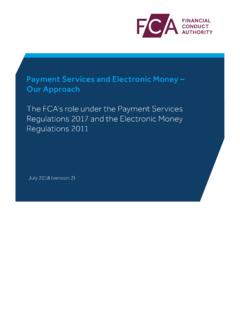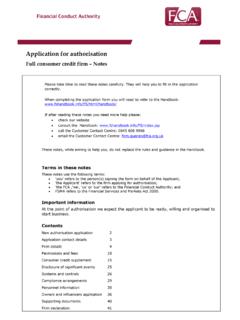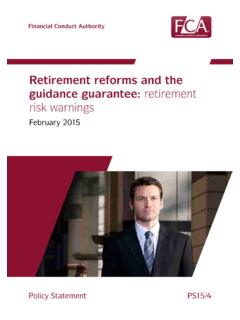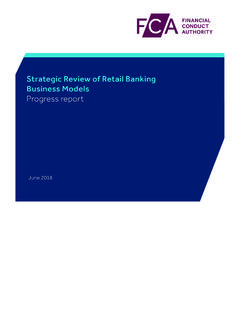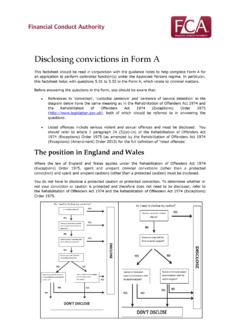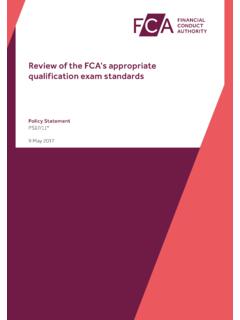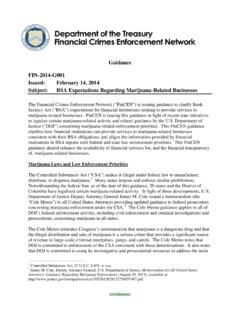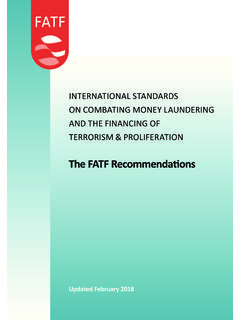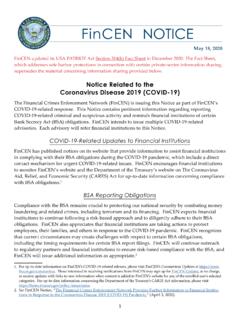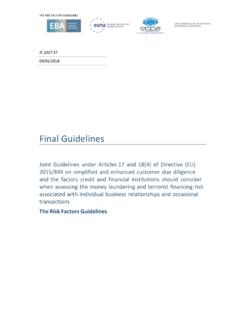Transcription of Decision Notice 2021: HSBC Bank plc
1 Page 1 of 51 Decision Notice To: HSBC Bank plc Firm Reference Number: 114216 Address: 8 Canada Square, London, E14 5HQ Date: 14 December 2021 1. ACTION For the reasons given in this Notice the Authority has decided to impose on HSBC Bank plc ( HSBC ) a civil penalty of 63,946,800. HSBC agreed to resolve this matter and qualified for a 30% (stage 1) discount under the Authority s executive settlement procedures. Were it not for this discount, the Authority would have imposed a financial penalty of 91,352,600. 2. SUMMARY OF REASONS All authorised firms are required to have systems and controls in place to mitigate the risk that they might be used to commit financial crime.
2 Firms must satisfy the Authority that they have adequate internal control mechanisms to manage their financial crime risk. Firms can detect, prevent and deter financial crime by using effective systems and controls. A firm must carry out ongoing monitoring of its business relationships. This includes scrutiny of transactions undertaken throughout the course of a relationship to ensure that transactions are consistent with a firm s knowledge of the customer, business and risk profile. The Money Laundering Regulations 2007 (the ML Regulations ), which were in force during the relevant period, required firms to establish and maintain appropriate and risk-sensitive policies and procedures relating to that ongoing monitoring of business relationships in order to prevent money laundering and terrorist financing.
3 Firms were also required to establish and maintain appropriate and risk-sensitive policies and procedures for the monitoring and management of compliance with, and internal communication of, those policies and procedures. The purpose of monitoring is to identify unusual or uncharacteristic behaviour by customers and patterns of behaviour which are characteristic of money laundering or terrorist financing, which after analysis may lead to a suspicion of money laundering or terrorist financing. It can also help firms to know their customers, Page 2 of 51 assist in assessing risk and provide assurance that the firm is not being used for the purposes of financial crime.
4 HSBC is part of HSBC Group, which is one of the largest banking and financial services institutions in the world. At the end of the relevant period HSBC had million active customers and during the relevant period 2 of its key transaction monitoring systems monitored around transactions per month. With such significant volumes of customers and transactions , HSBC used automated transaction monitoring systems to seek to establish and maintain appropriate risk-sensitive policies and procedures prescribed under the ML Regulations. HSBC also had policies to monitor and manage those automated transaction monitoring systems.
5 The standards set by these polices reflected HSBC s understanding of the key components required in automated transaction monitoring systems appropriate for a firm such as HSBC, including those key components that are the subject of this Notice . Between 31 March 2010 and 31 March 2018 (the relevant period ), HSBC failed to comply with the ML Regulations because its policies and procedures for 2 of its key automated transaction monitoring systems were not appropriate or sufficiently risk-sensitive, and HSBC did not ensure the policies that managed and monitored those systems were adequately followed. This is because, despite being aware of their importance from as early as December 2007, 3 key components of HSBC s automated transaction monitoring systems were deficient: (1) Scenario coverage: a.
6 A failure to consider whether scenarios covered risk indicators faced by HSBC until 2014 and a failure to carry out timely risk assessments for the new scenarios rolled out after 2016; b. inadequate monitoring coverage for risk indicators faced by HSBC; and c. design issues with two of the scenarios rolled out after 2016 which contributed to a significant number of overdue alerts delaying the identification of potentially suspicious activity. (2) Parameters: a. a failure to test and update thresholds prior to 2016 and new thresholds rolled out after 2016 to ensure that potentially suspicious activity was being identified; b. certain thresholds set in such a way that it was almost impossible for the relevant scenarios to identify potentially suspicious activity; and c.
7 The inclusion of rules that suppressed instances of potentially suspicious activity prior to August 2016 and a failure to understand those rules. (3) Data: a. a failure throughout the relevant period to check the completeness and accuracy of data fed into its transaction monitoring systems; b. a failure to maintain a list of its correspondent banking relationships so that all necessary data could be fed in and monitored; and c. incomplete and inaccurate data fed into the automated transaction monitoring systems. Together these failings often meant types of Page 3 of 51 transactions which were in the millions in volume and billions of pounds in value were either monitored incorrectly or not at all.
8 Despite its policies requiring HSBC to maintain each of these components throughout the relevant period, HSBC failed to do so. HSBC identified some of these deficiencies as early as March 2010. HSBC later undertook a large-scale remediation programme beginning in late 2012, which spanned multiple years. In doing so, HSBC made material progress in addressing many of the deficiencies that they had identified. However, notwithstanding the considerable investment made, its transaction monitoring systems still had serious weaknesses throughout the relevant period. HSBC continued to invest in future remediation in order to address these weaknesses even after the relevant period.
9 The Authority therefore considers that HSBC has failed to comply with: (1) Regulation 20(1)(a) of the ML Regulations to establish and maintain appropriate and risk-sensitive policies and procedures; and (2) Regulation 20(1)(f) of the ML Regulations to establish and maintain appropriate and risk-sensitive policies and procedures for the monitoring and management of compliance with, and internal communication of, those policies and procedures. Consequently, HSBC did not establish and maintain appropriate and sufficiently risk-sensitive policies and procedures to identify unusual transactions or those that may be indicative of money laundering or terrorist financing.
10 The Authority considers HSBC s failings to be particularly serious because: (1) Many of the failings occurred over a prolonged period of time despite numerous internal and external reports highlighting these failings throughout the relevant period. This meant that for a prolonged period of time HSBC failed adequately to detect and report potentially suspicious activity; these reports may have assisted law enforcement in their active investigations; (2) HSBC was also put on Notice of the potential weaknesses in this area in 2012 when the Department of Justice found that HSBC Group s subsidiary failed to monitor wire transactions from Mexico, partly due to failings in CAMP.

